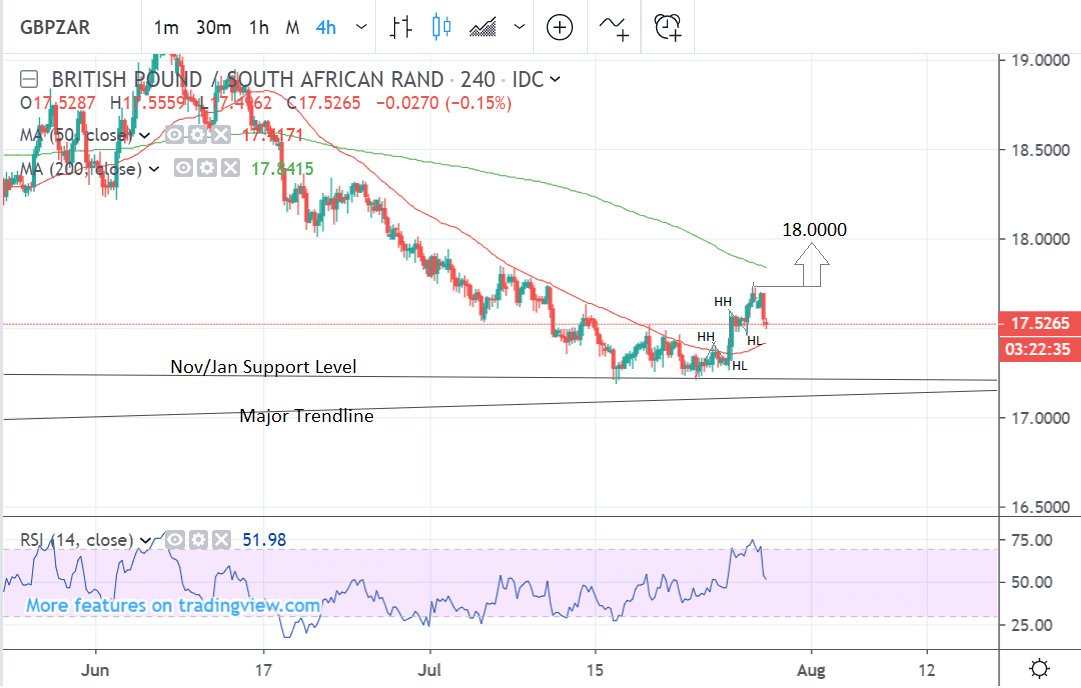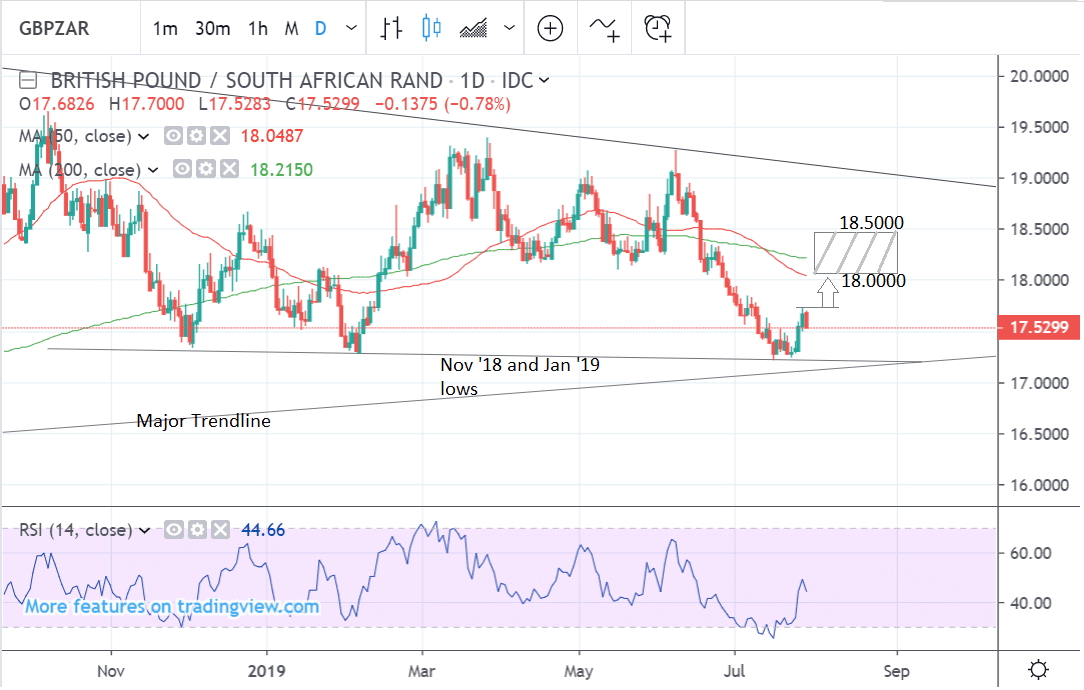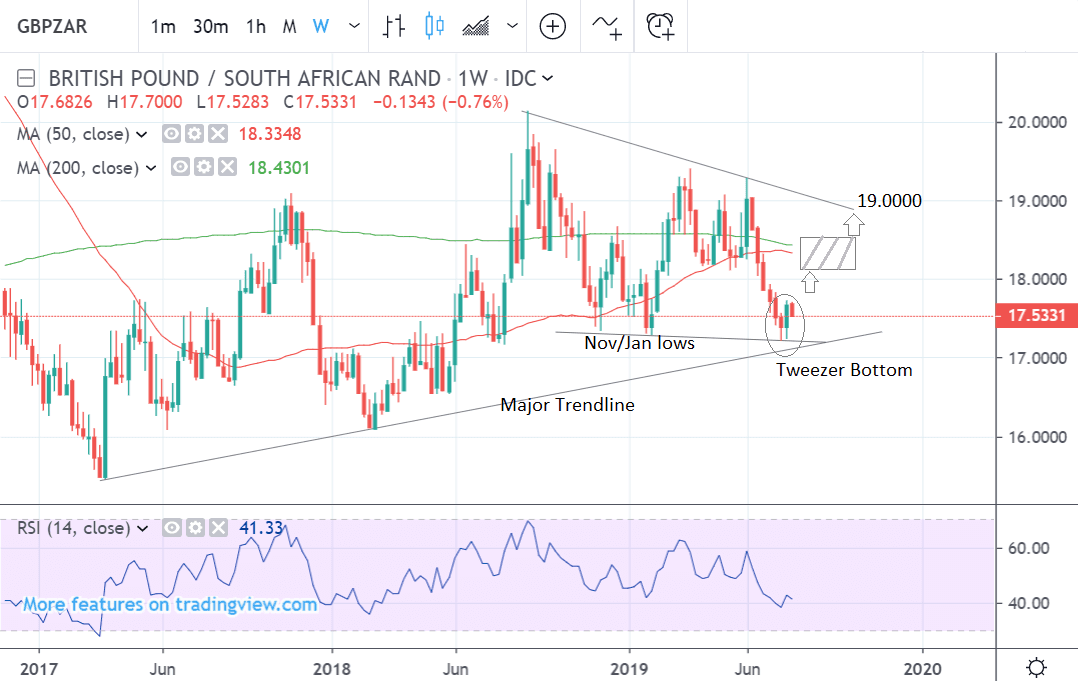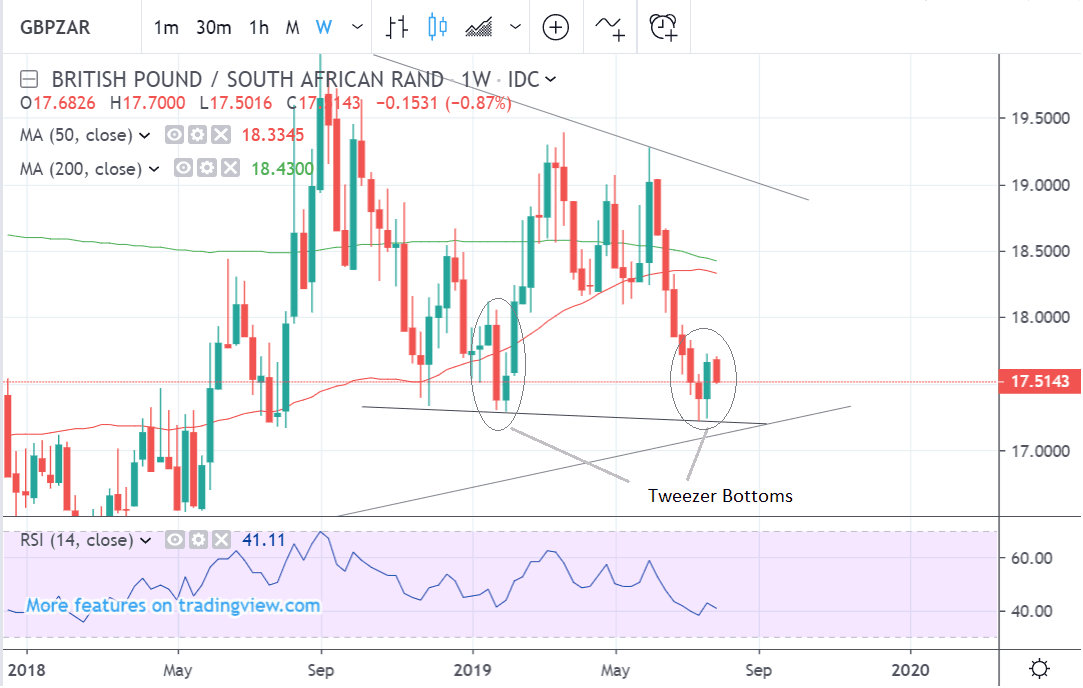South African Rand Jumps Against Sterling, but a Move Higher in GBP/ZAR still Possible this Week
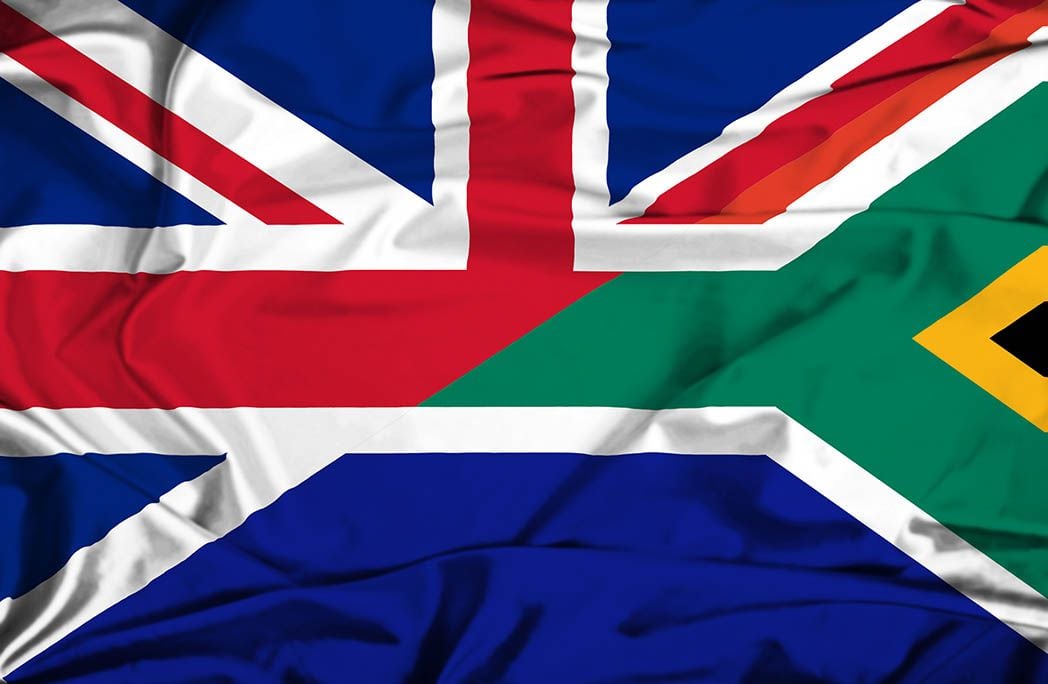
Image © Adobe Images
- Sharp selloff at start of new week
- But potential for gains, conditional upon upside break
- Rand to be moved by FOMC and China data
The Pound-to-Rand exchange rate is trading at around 17.42 on Monday, down 1.40% already on the day amidst a broad-based sell-off in the Pound.
Declines are lead by a ramping up of fears that a 'no deal' Brexit will occur on October 31 following various news reports made over the weekend.
Markets went into this week on an assumption that a 'no deal' Brexit was a 30% probability: there is clearly a good deal of space for those assumptions to rise if traders believe the new government is in fact serious about delivering a Brexit 'at all costs' come the Oct. 31, suggesting yet deeper downside in the Pound.
But studies of the GBP/ZAR charts suggest the pair could actually find support and extend higher in the week ahead.
The 4-hr chart - used to determine the short-term outlook which includes the coming week or next 5 days - shows how the pair has bounced off a major trendline as well as a historic support level.
This level previously acted as a ‘safety net’ to price in November 2018 and January 2019 which then went on to begin strong rallies; the inference is that the level is acting in a similar way this time.
And this seems to have been what has happened: after touching down and making a low on July 17 the pair reversed and started going higher. It has since formed two sets of higher highs (HH) and higher lows (HL), which is indicative of the start of a new trend.
The RSI momentum indicator is not particularly dissuading us from our bullish view either since is has just exited the oversold zone above 70 which means it is no-longer at risk of heralding a pull-back. In fact, the pull-back is already happening. Once it steadies and reverses the pair will probably resume its short-term uptrend.
Our bullish forecast is conditional on the pair successfully breaking above the 17.73 highs - if so it is forecast to extend higher to a target at 18.00.
The daily chart - used to give us an indication of the outlook for the medium-term, defined as the next week to a month ahead - shows the pair bouncing off the major support levels discussed above.
The key thing on the daily chart is the major moving averages (MAs), the 50 and 200 day MAs, which sit at 18.05 and 18.22 respectively. These are likely to impede upside progress as MAs can act as dynamic resistance levels - not just as market equilibrium points.
This explains the box with grey hatching above the 18.0000 target on the daily chart above, which is a zone where the pair is likely to encounter heavy selling from the MAs, as technical traders attempt to profit by scalping expected pull-backs. The zone ends at around 18.50 which is the upper end of possible forecasts.
The weekly chart - used to give us an indication of the outlook for the long-term, defined as the next few months - shows how the pair will probably rise above the resistance zone represented by the box with grey hatching, over the long-term (assuming the uptrend extends) and then probably hit a target at 19.0000 where another trendline conjoining the September ‘18 and June ‘19 highs is situated.
The chart also shows how the pair has formed a ‘tweezer bottom’ bullish reversal pattern over the last two weeks. This is the name of a Japanese candlestick pattern in which the level of the lows of two adjacent candles is very similar as well as the distance from the low to the body.
Note how a similar tweezer bottom pattern signalled the reversal at the January lows, as shown on the chart below.
Time to move your money? Get 3-5% more currency than your bank would offer by using the services of foreign exchange specialists at RationalFX. A specialist broker can deliver you an exchange rate closer to the real market rate, thereby saving you substantial quantities of currency. Find out more here.
* Advertisement
The South African Rand: What to Watch this Week
With little of note in the week ahead on the domestic calendar we look to exogenous drivers as the main influencers of the SA Rand.
Chief of these will probably be the U.S. Federal Reserve which decides whether to cut interest rates or not. The Rand is highly negatively correlated to the U.S. Dollar so what is good for the Dollar is bad for the Rand and vice versa.
There are three possible outcomes to the Fed meeting - no change in policy, a 0.25% cut and a 0.50% cut. The middle option of a 0.25% cut is the most likely according to market-based predictors of the outcome.
Markets are well positioned for a rate cut on Wednesday, therefore the rate cut itself is likely to be market neutral.
What matters is the signal the Fed gives as to future decisions: if the communication suggests more rates are likely than the market expects, then the Dollar will likely fall. If the Fed sounds a more upbeat tone, thereby hinting that it perhaps only one more cut is coming, the Dollar could instead rally.
This would in turn likely hit the Rand. Recall, many emerging market currencies are inversely correlated to moves in the Dollar, particularly if they have a sizeable national debt denominated in Dollars. If the value of the Dollar rises, the value of the country's debt pile rises too. The majority of South Africa's national debt is in fact denominated in rands, therefore this is not as sizeable an issue as it is for other emerging market peers. However, South Africa runs a trade deficit, meaning it imports more than it exports, and therefore the cost of imports rises alongside the Dollar.
Fuel imports are particularly important for the economy.
The other important event is the release of Chinese Manufacturing PMI data on Wednesday which is forecast to show a recovery to 49.6 from 49.4. Both Chinese and global manufacturing have been hit lately and investors will be watching the July PMI data for signs as to whether the trend is continuing. If forecasts are accurate and the outlook has improved somewhat the Rand along with other emerging market currencies could gain a lift.
The outlook for the SA economy has declined after the euphoria which accompanied the re-election of Cyril Ramaphosa.
Credit rating agency Fitch recently downgraded the outlook for SA from neutral to negative BB+ reflecting a “fiscal deterioration”. If Moody’s follows suit it will resurrect fears of a downgrade to sub-investment grade. Moody’s is the last of the big three rating agencies to maintain SA debt at above investment grade, but only by one notch. If it were to downgrade the country it would fall below investment grade triggering a flight out of SA by global investors and the Rand would fall off a cliff.
“Fitch is clearly sceptical about government implementing policy changes to improve the fiscal and growth prognoses. The outlook downgrade came quite unexpectedly; we, therefore, expect a negative market reaction today. Investors tend to focus more on Moody’s and S&P than Fitch; we however now expect similar concerns from both Moody’s and S&P,” says Shireen Darmalingham, an economist at Standard Bank.
Data, although minor in the week ahead may, nevertheless, contribute to the debate about the SA economy triggered by the Fitch downgrade.
Unemployment reached a 2-year high of 27.6% in Q1 and analysts will be keen to see if the latest figures for Q2 continue the trend when released at 10.30 on Tuesday. If there is an even deeper contraction it could increase concerns about the economy and the threat of a downgrade.
Given fears about “fiscal deterioration” the main budget balance could have an impact on the Rand when it is released at 13.30 on Tuesday. If it comes out at a surplus, as expected by ABSA bank, which forecasts a 39.5bn ZAR surplus, from a deficit of -17.5bn ZAR previously, it could ease the pressure on the currency.
Time to move your money? Get 3-5% more currency than your bank would offer by using the services of foreign exchange specialists at RationalFX. A specialist broker can deliver you an exchange rate closer to the real market rate, thereby saving you substantial quantities of currency. Find out more here.
* Advertisement

